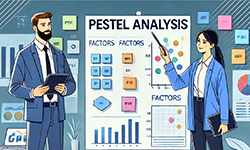
In today’s fast-changing business world, it’s crucial to understand the external forces that impact organizational strategy and decision-making. A methodology like PESTEL analysis provides in-depth insights into these complex factors, aiding companies in navigating their challenges successfully. This article outlines the steps to conduct a PESTEL analysis, highlighting its importance in fostering informed decision-making and enhancing critical thinking skills.
Definition: PESTEL analysis
PESTEL is both an abbreviation and acronym, that represents the external factors affecting a business, both now and in the future: political, economic, social, technological, environmental, and legal. A PESTEL analysis, rooted in marketing principles, serves as a tool for companies to monitor these environmental factors and their impact on business operations. Companies typically conduct PESTEL analyses when planning to launch new products and market initiatives, expand services, or undertake new projects, ensuring they consider all relevant external influences. Compared to PEST, PESTEL offers a more comprehensive overview by including environmental and legal factors, which are essential components of a market analysis.
PESTEL analysis factors
The PESTEL analysis features six main factors that can have an outsized impact on entire industries, as well as the performance and growth of a business. These factors include:

Political factors
This is the first of the PESTEL factors. Political factors in the PESTEL framework focus on how government policies and the political environment impact businesses and entire industries. Consider businesses in particular countries and think about how the government may intervene in economic activity. Governments have a substantial influence on the health, education, and other public sectors of a nation. With elections come new pieces of legislation, which in turn influence business activity. These factors shape the rules and regulations that companies must follow and can significantly influence future markets. Government policies, such as tax laws, trade regulations, and safety standards, impact various aspects of business operations. Additionally, the political environment, including government stability and changes in leadership, influences business confidence and investment. Key political factors that alter the business environment include political stability, tax guidelines, trade and safety regulations, and employment laws.

Economic factors
This element examines how economic factors have a profound impact on business performance. Key factors include inflation, unemployment, exchange rates, economic growth, and consumer disposable income. Each of these factors directly influences a company’s performance and operational strategies. For instance, economic growth and unemployment rates affect consumer purchasing power, which in turn impacts product demand. A decrease in demand can influence the supply and pricing of a company’s products and services, leading to potential adjustments in inventory and production levels. Additionally, fluctuations in exchange rates can influence the cost of imports and exports, thereby impacting profitability. Companies engaged in international trade are particularly vulnerable to exchange rate volatility, which can lead to increased costs or reduced revenue. Moreover, inflation rates can impact the purchasing power of consumers and the cost of raw materials, necessitating price adjustments. Businesses must closely monitor these economic indicators to anticipate labour market trends and adjust their strategies accordingly to ensure competitiveness.

Social factors
The social environment encompasses elements like demographic characteristics, customs, norms, and the values of the population, all of which significantly impact business operations. Employment patterns, social responsibility, and sociocultural factors also play critical roles in shaping a company’s performance within the socioeconomic environment. Elements such as age distribution, income, population growth, and career attitudes affect demand for products, pricing, and supply quantities, which in turn influence overall business growth. For instance, population growth can increase product demand, impacting prices and supply. Additionally, shifts in social attitudes can have a devastating impact on business practices and market strategies. When analysing social trends, ensuring the reliability and validity of your information is crucial for making informed decisions.

Technological factors
Technological factors significantly influence the way a business operates, having a substantial impact on the globalization of target markets. Various aspects of the tech market can affect a business’s performance, either positively or negatively. These technological factors also play a crucial role in a business’s decision to introduce a new product in specific markets or invest in a particular product. Understanding technological trends can either encourage or discourage a business from investing in certain technologies. For instance, if a tech product that contributes to a business’s success is anticipated to become obsolete soon, a company is unlikely to spend money on it. The same principle applies to apps and related technologies. The impact of globalization further emphasizes the importance of staying updated with technological advancements to maintain a competitive advantage in the global market.

Environmental factors
Environmental factors significantly impact the performance and operations of a business, especially in the current economy. These factors include issues such as raw material shortages, pollution, and carbon footprints. Ecological elements like climate, weather, and environmental changes also play a crucial role. Businesses in sectors like farming, tourism, insurance, and agriculture are particularly affected. For instance, changes in weather and climate can influence the success of the farming industry, which influences the availability of raw materials. This, in turn, impacts the supply chain of a company, leading to fluctuations in product prices and ultimately influencing consumer purchasing decisions. To mitigate these challenges, a sustainable company must adopt eco-friendly practices and innovate to ensure long-term viability in an ever-changing environment.

Legal factors
The last element of the PESTEL analysis is legal factors, which are in many ways similar to political factors but are more specific. Legal factors include labour laws, discrimination laws, consumer protection, and patent and safety laws, among others. This aspect highlights the necessity for companies to have a thorough understanding of legal affairs that affect their operations. For instance, trademark laws can influence the growth of a company looking to trademark and introduce new products. Worker rights laws will impact the HR department, shaping policies and practices. Additionally, a business’s performance is influenced by its compliance with public safety regulations and ingredient regulations, underscoring the importance of adhering to legal standards.
How to conduct a PESTEL analysis
When conducting the PESTEL analysis, consider the following steps:
- Understand the factors: Identify and assess the key external factors that influence your business environment, including political, economic, social, technological, environmental, and legal elements. These factors can affect your operations, market potential, and profitability in various ways. Understanding them provides a foundation for conducting a thorough PESTEL analysis.
- Gather information: Conduct thorough research to gather data from reliable sources like government publications, industry reports, and expert opinions. This crucial step helps you collect the necessary information to analyse each factor effectively. Ensure your data is current and comprehensive to provide accurate insights.
- Analyze each factor: Examine the gathered data to identify trends, opportunities, and threats for each factor. Analyze how these elements impact your business, considering both positive and negative effects. This step helps prioritize factors based on their potential influence.
- Evaluate the impact: Assess the severity and likelihood of each identified opportunity or threat. Prioritize factors based on their potential impact on your business, and create a matrix or chart to visualize their significance. This evaluation aids in understanding which factors require immediate attention.
- Develop strategies: Develop strategic responses to address the identified factors, focusing on capitalizing on opportunities and mitigating risks. Align these strategies with your organization’s goals and resources, and assign responsibilities and timelines for implementation. Effective strategies ensure your business adapts to external changes.
- Monitor and review: Regularly update your PESTEL analysis to reflect changes in the external environment. Establish a schedule for periodic reviews, monitor key indicators, and adjust strategies based on new information. Continuous monitoring ensures your analysis remains relevant and supports informed decision-making.
PESTEL analysis example
To further your understanding of this specific topic, we’ll provide a comprehensive yet simple example. Below, we have conducted a PESTEL analysis for a renewable company, which is as follows:
Why is a PESTEL analysis important?
A PESTEL analysis can play a great role in the success and growth of a business. The tool helps business owners identify significant changes in political, economic, social, technological, environmental, and legal factors. Additionally, it can help business owners plan the expansion of their business into different or foreign markets. By conducting a PESTEL analysis, business owners will be able to ensure they’re sufficiently controlling all business departments and, in turn, will be able to generate more revenue.
Furthermore, PESTEL analyses can be combined with SWOT analyses to ensure that opportunities are maximized while threats are minimized. First, conduct a PESTEL analysis, and then use the external business opportunities and threats to assist you with your SWOT analysis. The results of both analyses greatly assist businesses with smart decision-making. Once the decision has been made and the changes are implemented, it’s important to carry out benchmarking to ensure continuous improvement in the business processes.
FAQs
PEST and PESTEL analyses are both economic tools. They are used to evaluate certain aspects of a business or corporate environment. The primary distinguishing factor between the two tools is that a PESTEL analysis includes two additional factors. A PEST analysis looks into political, economic, social, and technological aspects. PESTEL tackles all the aspects mentioned above, plus legal and economic factors. Other than the two additional factors, there isn’t much of a difference between the two economic tools as they perform the same function.
Both PESTEL analyses and SWOT analyses are used to analyse the environment in which a product is meant to take its place. The differences between the two tools are that PESTEL analyzes external factors while a SWOT analysis focuses on both internal and external factors. They are both incredible tools with benefits and downsides.
The main advantage of a PESTEL analysis is that it simplifies the analysis process by using major macro-environment factors. The tool also helps to identify potential threats through external factors. It, therefore, allows businesses to develop strategies to counter the potential issues. On the other hand, the primary benefit of a SWOT analysis is that it presents data in the simplest way for easier comprehension. It also covers significant areas like competition and potential weaknesses that need to be addressed.
The downside of PESTEL is that it only covers external factors. On the other hand, the downside of a SWOT analysis is that it lacks prioritization of key problem areas. When deciding which of the two is the better option, consider the advantages and downsides of each.
In 1967, a Harvard professor called Francis Aguilar created an analysis tool called ETPS. It was later renamed to the acronym PESTEL that we know today.
